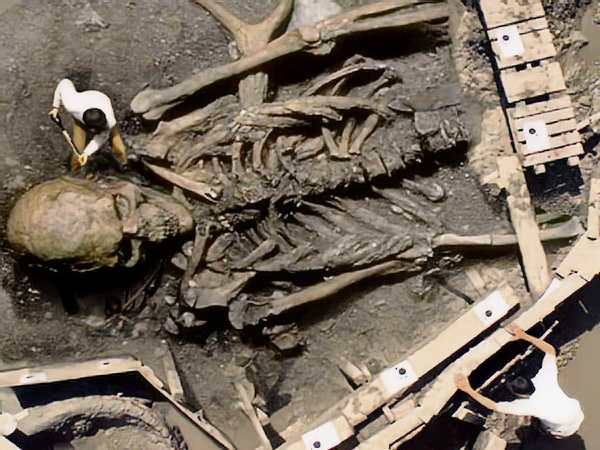The phenomenon of giant skeletons has long fascinated historians and cryptozoologists alike. Reports from the mid-to-late 1800s describe startling discoveries of enormous human-like bones, sparking intrigue and speculation. From towering remains unearthed in Indian mounds to peculiar finds in private collections, these stories continue to captivate imaginations. Let’s explore some of these extraordinary accounts and examine why these giant skeletons remain shrouded in mystery.
Unearthing the Giants: 19th-Century Reports
In 1879, an excavation near Brewersville, Indiana, revealed a nine-foot-eight-inch skeleton buried in an Indian mound. This discovery was followed by another remarkable find in Ashland County, Ohio, where George W. Hill, M.D., unearthed a skeleton of “unusual size.” These reports were not isolated incidents; they were part of a broader trend of giant skeleton discoveries that seemed to proliferate during this era.
In 1880, the American Antiquarian documented a large skeleton found by Dr. Everhart near Zanesville, Ohio. This skeleton was reportedly encased in a clay coffin with mysterious hieroglyphics on a sandstone slab. Similarly, in 1881, a series of nine unusually large skeletons were found beneath a house’s cellar in Medina County, Ohio. Albert Harris, a local resident, noted that one of these skeletons was so large he could fit it over his head like a helmet.
The 19th century was also a time when many authors, including Mark Twain, spun elaborate tales that often blurred the line between fact and fiction. This era’s penchant for sensationalism raises questions about the authenticity of these giant skeleton reports. Were these accounts factual or merely embellishments of the time?
Smithsonian Reports and Official Accounts
To delve deeper into these mysteries, I examined historical records from the Smithsonian Institution. In 1894, Cyrus Thomas and Thomas Powell of the Bureau of Ethnology documented several large human skeletons. One notable find occurred in Roane County, Tennessee, where a skeleton measuring 7 feet 3 inches was discovered. Another large skeleton found in Dunlieth, Illinois, was reported to be between 7 and 8 feet long but crumbled upon removal.
These reports suggest that such discoveries were not confined to local folklore but were noted by reputable institutions of the time. Despite this, the frequency of these finds has drastically declined in modern times. This leads to the question: if these giants once roamed our past, why don’t we see similar discoveries today?
The Mystery of Missing Relics
The disappearance of giant skeletons is another puzzling aspect. In discussions with Brad Steiger, author of Worlds Before Our Own, he revealed that private museums housing such relics suffered unexplained fires after his book was published. This raises intriguing questions about why these artifacts might be deliberately hidden or destroyed. Are there powerful interests working to suppress evidence of these ancient giants?
Further complicating the mystery is the case noted by the late zoologist Ivan T. Sanderson. In the 1960s, Sanderson received a letter from an engineer who had uncovered giant human remains while building an airstrip on the Aleutian island of Shemya during World War II. The remains included skulls measuring up to 24 inches and showed signs of trepanation. Despite confirmation from another unit member, records of these findings were not made public. Sanderson speculated that the Smithsonian might have retrieved these remains, but no official record exists.
Modern Implications and Theories
The intriguing question remains: are giant skeletons the stuff of legend or hidden historical artifacts? If such remains were once prevalent, what has caused their disappearance? Theories abound, ranging from deliberate suppression by institutions to simple misidentifications of large, but ordinary, remains.
Some suggest that the giant skeletons might be the result of exaggerated reports or misidentified animal bones. Others believe that ancient records could have been lost or destroyed over time. Yet, the consistency and detail of these historical accounts add weight to the possibility that something extraordinary once existed.
Conclusion: The Ongoing Enigma
The tale of giant skeletons from the 19th century to present day continues to be a source of fascination and debate. Whether these giants were real or merely products of a sensational era remains unresolved. The blend of historical accounts, official reports, and mysterious disappearances adds layers to the enigma of giant skeletons.
While modern discoveries may be rare, the historical accounts and ongoing questions about these relics keep the mystery alive. As we continue to explore and uncover the past, perhaps one day we will resolve the enigma of the giants that once intrigued our ancestors. Until then, the quest for understanding continues, fueled by curiosity and the allure of the unknown.

